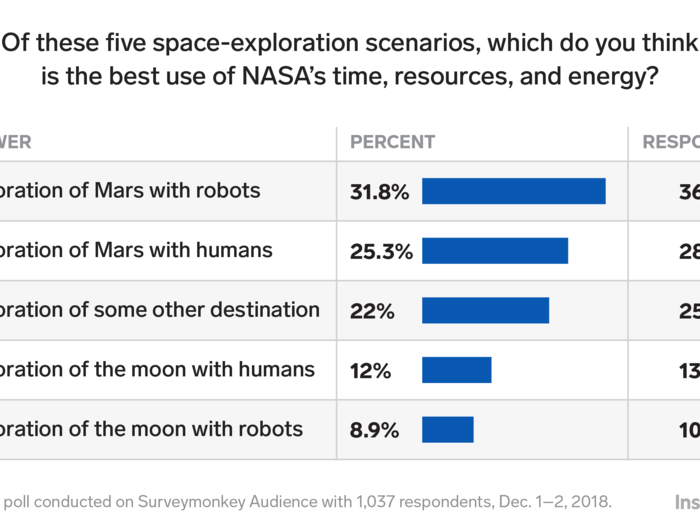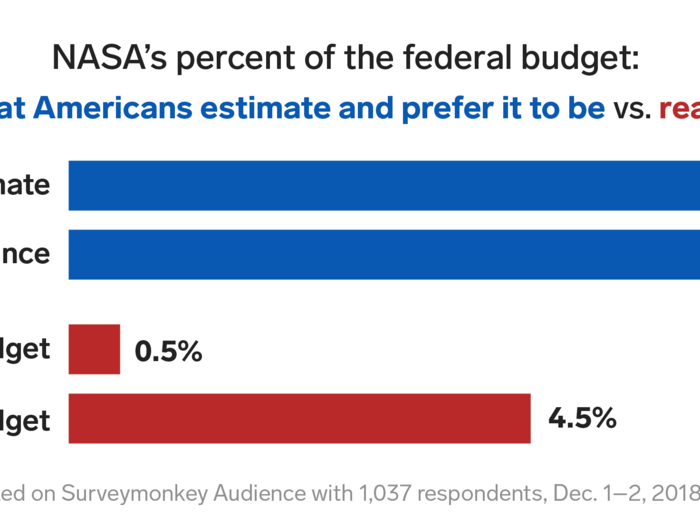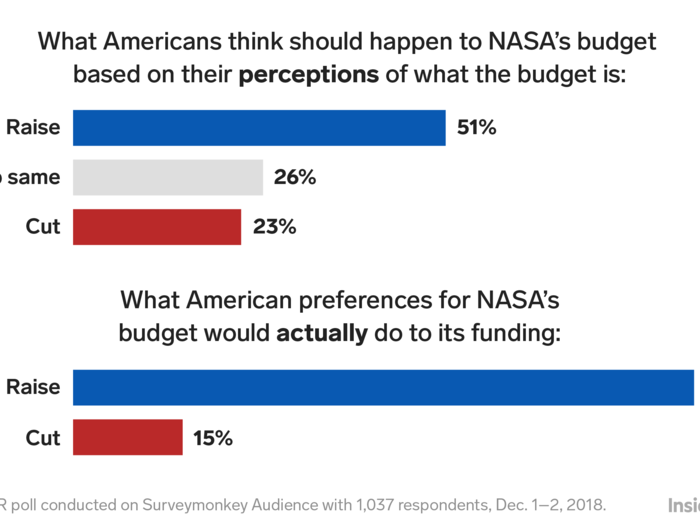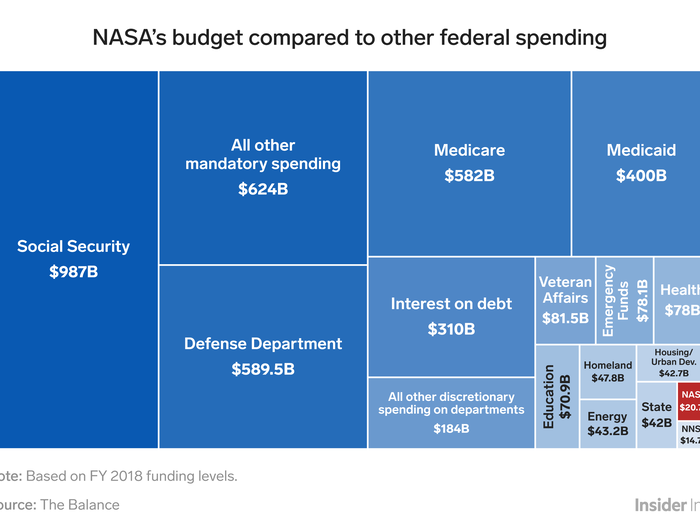- Home
- slideshows
- miscellaneous
- Most Americans don't know NASA's share of the federal budget - but 85% would give the space agency a big raise
Most Americans don't know NASA's share of the federal budget - but 85% would give the space agency a big raise
Most Americans think NASA should return to the moon, but they disagree about what that lunar exploration should looks like.

Mars exploration seems to be most important to the public, though.

Though many survey respondents want NASA to go back to the moon, less than 21% think it's a top priority for the agency. Instead, about 57% of people surveyed want Mars to be NASA's main focus.
A little more than half of the pro-Mars respondents want that exploration to be robotic (like NASA's Mars InSight lander). A little less than half want to see humans visit the red planet (as does Elon Musk).
Between one-fifth and one-quarter of people want the space agency go somewhere else entirely.
The poll didn't ask for specifics, but those alternative destinations might include ice-covered moons like Europa at Jupiter or Enceladus at Saturn — both of which may hide subsurface oceans, and perhaps even alien life. Or maybe they'd like NASA to revisit Ceres (an icy dwarf planet in the asteroid belt), land a new spacecraft on Venus, or invest in an ambitious interstellar mission like Breakthrough Starshot.
Americans wildly overestimate how much money NASA gets each year.

Ask a US resident to estimate what share of federal funding their space agency gets, and you'll get some widely varied answers.
In fact, some answers to this question were so wild that the top 5% and bottom 5% of responses have been removed (some were "0%" and others were "100%") to ensure the chart here shows a more representative result.
Still, less than two-fifths of the US-based respondents guessed within one percentage point of the correct portion. In reality, the agency's fiscal year 2018 budget was 0.5% of all annual federal spending. That translates to about $20.736 billion of some $4.173 trillion total.
The average respondent, however, thinks NASA currently gets about 6.4% of all federal dollars. If that were true for 2018, NASA would have $267 billion to work with — about 13 times as much as it currently gets.
When asked how much NASA should get, respondents suggested an even larger share: 7.5% of the federal budget, on average. That's about $313 billion, or more than 15 times the current level.
That preferred funding level is far more than NASA got during the peak of the Apollo moon-landing program. During that time (when the agency had its biggest budget share ever) NASA got nearly 4.5% of the federal budget.
If NASA really got 7.5% of the current national budget, that would be enough to build two football-field-size International Space Stations in a single year. (The one we currently have took about two decades.) One year's worth of this funding might also be enough to send a crewed mission to Mars, according to one government estimate.
Even people who think NASA's budget should get cut would actually increase funding.

A little more than half of respondents would vote to raise NASA's budget, while more than one-quarter indicted they want to keep it at current levels. The rest of the respondents said they want NASA to get less funding.
But it turns out that if you compare everyone's stated preferences to NASA's actual funding level, 85% of people still suggest a higher share than NASA's current 0.5%. That means many of the people who thought they wanted to cut NASA's budget or keep it the same would actually give the agency a raise.
The reality of government spending is complex and contentious.

The chart above, called a tree map, shows the federal government's 2018 fiscal year budget based on numbers provided by The Balance.
Each box represents the relative size of that part of the budget. As you can see, Social Security, other mandatory spending, Department of Defense (DoD), Medicare, and Medicaid make up about three-quarters of the map.
NASA is the small red box at the bottom right. In terms of all main spending programs, including discretionary and mandatory, NASA is second-to-last. (The smallest box is the National Nuclear Security Administration.)
If you're wondering what NASA might do with a budget as big as the DoD's, here are some ideas.
SurveyMonkey Audience polls from a national sample balanced by census data of age and gender. Respondents are incentivized to complete surveys through charitable contributions. Generally speaking, digital polling tends to skew toward people with access to the internet. SurveyMonkey Audience doesn't try to weight its sample based on race or income. Total 1,037 respondents polled Dec. 1–2, 2018, margin of error plus or minus 3.11 percentage points with 95% confidence level.
Popular Right Now
Popular Keywords
Advertisement